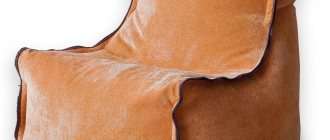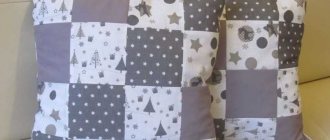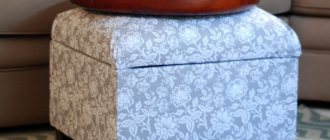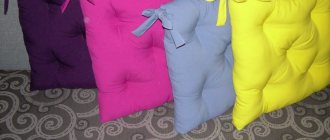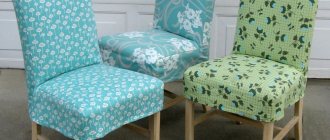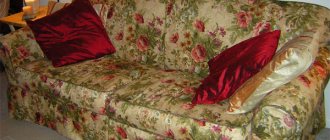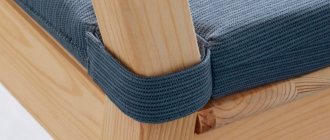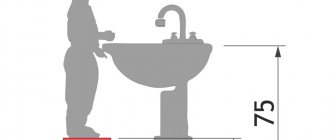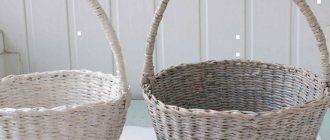Sewing a cover for a high chair with your own hands becomes relevant when: 1) the old cover is damaged for various reasons; 2) he did not exist at all; 3) you just don’t like the old high chair cover. Let's look at all three options and show you how you can sew a cover for a children's high chair with your own hands.
At the very beginning, I would like to add the following, common to the three options: it is impossible to provide a ready-made diagram of a universal cover for any high chair, and even with dimensions. The fact is that the chairs are all different, and the cover is sewn depending on their design. Therefore, when creating a pattern, you will need to start from a specific model of a high chair or its old cover. And as a universal one, there will be general recommendations on how to sew a chair cover.
Below is a brief retelling of popular master classes on the topic of how to sew a cover for a high chair with your own hands. All these lessons come down to the sequence of certain actions. And let’s add a few practical considerations of our own.
High chair cover - choice of material
Before you try to sew a cover for a high chair with your own hands, you need to find a suitable material. Many parents like bright colors, or, conversely, beautiful delicate colors, especially if a girl is growing up. In addition, I want my children to have the best. Therefore, soft velor and some other soft, easily soiled fabric, such as cotton calico, are chosen. Kind of like a blanket or throw for a sofa.
Let’s say right away that it’s impractical to think like that. A small child will immediately sweep away all your beauty. He still has his own ideas about this world, and the most important thing for him is active movement. Including while in a high chair. Therefore, the more interesting and expensive the high chair cover is, the less it will last.
Let’s say separately that chintz will quickly lose its appearance, it will be a pity for the labor invested, and therefore we don’t take it at all.
Based on the needs and lives of children, it is worth starting from the following: it is best to sew a cover or cover for a baby’s feeding chair with your own hands from fabric on an oilcloth base, and it should not be of easily soiled tones. You can simply use any washable, strong fabric, such as raincoat fabric. Oilcloth is very easy to wash, and a certain color will help hide endless dirt. And there will be a LOT of it: from overturned porridge, to things painted with a pen - this is already for grown-up kids. Therefore, we choose the fabric of the cover for a children's high chair in a neutral tone, or with a bright pattern and on an oilcloth base. The finished case should be filled with soft filling, such as synthetic padding. Sitting on a soft cover on a high chair is always more pleasant for a child than on a hard chair.
To prevent shrinkage of the already sewn high chair cover, its fabrics are decated before sewing. The easiest way is to wash the fabric before cutting. There is a more correct way - to wet the fabric in water with a temperature similar to that with which people will then wash. This is about 60C – 90C. hang to dry and iron with damp, pressing movements. Then you can start cutting and sewing.
Decatting of fabric is a wet-heat treatment in order to prevent shrinkage of the fabric during work and use of the finished product.
Now for those who complain that the baby is sweating in the high chair. Of course, sitting on oilcloth, the baby will sweat, especially in summer or winter with good heating. A diaper placed between the baby and the high chair can easily prevent this. Also, a diaper can be an alternative to a new cover for a high chair for feeding, for those who do not want to bother with the cover.
An easy way to sew a cover
Now we will share the fastest and easiest way to sew such a necessary product.
Let's take the following materials and tools:
- 2 square-shaped pieces of foam rubber (size depends on the back and seat of the chair).
- 1 piece of any very thick fabric of your choice.
- Bias tape.
- Narrow satin ribbon.
- Threads to match the fabric.
- Needle.
- Scissors.
- Sewing machine.
Let's get started:
- Now we need to measure the length of the baby’s seat in the high chair: the back and the seat. After this, add 15 cm to the bottom and top of the cover - this will serve as pockets for putting on a chair. The end result should be one solid piece.
- We retreat 15 cm from the top and bottom edges of the fabric and fold the fabric along the line. After this, we make a seam on the side, forming a pocket for the cover on the chair.
- We process the edges of the fabric with tape along the entire perimeter of the cover.
- Now we need to make ties to secure the cover to the chair. To do this, take a satin ribbon and cut it into 6 equal sections 10 cm long. We bend and stitch the edges of the strips or process them with an overlocker.
- We attach or manually sew the ties to the cover so that 2 of them secure the back, 2 - the side parts, and the rest - the seat of the high chair.
- To get your baby started using the high chair, place the cut out foam on the seat and back of the high chair.
- Place the sewn cover on top and tie all the ties to a bow.
This beautiful case is ready to do its job!
DIY high chair cover - removable option
Why do we make a removable cover for a high chair for feeding a child? This cover is easy to remove and wash. It can be put on top of an old cover. It will be even softer this way. If you plan to use the new cover without the old cover on the high chair, then you need to put more soft filling there. That's all.
Our hand-sewn removable high chair cover will have three layers of fabric:
- The top layer, also known as the face, is an oilcloth-based fabric or other fabric; according to your choice;
- Soft layer filler - batting, or synthetic padding, or even foam rubber, if the machine will accept it;
- The bottom one, also known as the lining, is ordinary hard, strong cotton and/or synthetic fabric, or lining.
The cover will be attached to the back of the high chair using a pocket. The pocket is a short piece of durable fabric, you can use the same one from which the lining for the case is made. It follows the shape of the upper part of the back, and is sewn to the cover from the back. On the sides the cover is attached to the chair using an elastic band or ribbons. High chairs are all different. This means that you yourself will need to look at the place - where and how much to sew so that it turns out well. If you use seat belts, you need to make holes. If you don’t use it, you can leave the cover on the high chair in a blind version.
You can see how to sew a cover for a high chair in the following video. It shows how you can sew a universal liner cover for a high chair. Unfortunately, there is no pocket and it is unclear what will hold the back of the cover against the back of the chair. However, the sewing sequence itself is shown correctly.
Sew a cover for a high chair with your own hands - the work process
To sew a cover for a high chair with your own hands, first make a pattern. Traditionally, tracing paper or just paper is used for this. It is also possible to take ordinary inexpensive thin white fabric for these purposes. A white background will make your marks easier to see. You can use non-woven fabric or cellophane, perhaps it will be even more convenient with them.
Remove the old cover from the high chair. If you need to rip it apart at the seams, then we do it. If it is not required, then you don’t have to spank F). We lay the cover on the pattern material. We press it tightly to the fabric (paper) and draw the pattern according to the material. On the pattern we mark the places of folds and stitching, as well as the places of holes.
After this, we cut out the pattern itself. When cutting, you need to leave an allowance of 2-3 cm in all directions from the pattern for seams. When the pattern for the new high chair cover is ready, you can start cutting out the necessary parts from the fabrics of the cover.
Let’s say right away that as a result of your actions on the do-it-yourself highchair cover, you should end up with a sandwich: a soft filler, the top layer (the main fabric of the cover) facing it, then the lining. If this does not work out, then when you turn out the already sewn cover, you will see for yourself that you did it wrong, and you will have to unrip it. In principle, this can be checked in advance on scraps.
Cutting begins with the lining and lapels. In addition, we separately mark a pocket on the lining fabric for attaching to the back of the high chair. We cut out the pocket and sew it to the lining. The lapels also need to be basted to the lining.
We place the resulting design with the flaps up on the front side of the main material of the chair cover. After this, we baste the finished structure to the main material, and only after that we cut out the cover from it. You can, of course, first cut according to the pattern and then sew it, but then something will definitely warp when sewing.
After this, place the entire new structure made of the main material and lining with the back side of the main fabric on the filling - padding polyester and also baste. And only after that cut out the filler.
When everything is cut out, sew the cover along the edges, leaving one part unstitched, through which the new cover for the high chair will be turned inside out.
The future cover is turned inside out, after which you need to make markings for stitching on it according to the pattern. They can also be basted and machine stitched. Also, if you decide to use it with belts, then you need to make holes for the seat belts. To do this, a stitch is used to make loops.
The hole through which the cover was turned inside out is sewn up, preferably with a hidden seam. You need to attach ties or an elastic band to the back and bottom of the cover.
That's it, you have sewn a new cover for the high chair. He's ready.
A little advice: if the old chair cover was not suitable for some reason, for example, it was too big, then the pattern should be made 1-2 cm narrower.
Do-it-yourself cover for a high chair - there is no old cover or we cover a new homemade high chair
Nowadays it is quite rare to find a high chair without a cover. Still, this is the age of comfort and consumption, so manufacturers take into account all the little things. But if this happens, or you made the chair yourself, then in this case you will have to think about the cover. You will have to make a cover for the high chair with your own hands. The difference from the first option is that there is no ready-made, albeit damaged, sample in front of your eyes.
Therefore, in this case, before making a pattern, you need to hang thin paper or fabric, for example, a white diaper, on a chair (the drawing is better visible on a light one). And directly according to the size of the chair, draw the desired pattern. And it is advisable not to forget about the lines along the intended folds. And if you forgot, so be it. Still, there is no old cover, and it is not known exactly where the stitches should be. The rest is done in the same way as in the first option for a removable cover for a children's high chair.
DIY high chair cover – wooden chair cover
The first two options for high chair covers imply that the cover will be removable. Most often, it is hung on a chair, similar to a mobile high chair. That is, it has a pocket sewn onto the back that fits onto the back of the chair. You can make the case universal, then you can do without a pocket, and use a soft filler that holds its shape, for example, foam rubber. We remind you that here the pocket is a short piece of durable fabric, repeating the shape of the upper part of the back, sewn to the cover from the back. Therefore, such universal covers will fit absolutely any model of high chair, you just need to sew them in accordance with the existing high chair.
For a wooden high chair, the cover is sewn slightly differently. First, let's look at the video, which simply and clearly shows the main points.
Now let’s look in more detail at what and how. The third option for sewing a cover for a high chair with your own hands is designed for wooden chairs.
It can be used when making a high chair with your own hands, or even if the old cover is worn out.
The bottom line is that the chair is simply upholstered with a brightly colored oilcloth using a construction stapler. A soft filler is first attached to the hard parts of the chair. For a stronger structure, the filler can be glued to the back of the chair, but it is better to attach the oilcloth itself with a stapler. The process itself is very similar to upholstering the most ordinary chair with fabric. Perhaps this option will be even easier than sewing a cover. It has, perhaps, only one drawback - it will be difficult to remove, unlike the removable cover for a high chair.
Where to buy?
There are many options for how to get such a case. Let's look at everything in order:
Order online
The easiest and most affordable way. Its advantages are as follows:
- Save time. All you have to do is type into a search engine what you want to buy - and you will see a ton of sites with pictures of the product. Choose and ask the price.
- Payment for the order can be made in any available way: online payment, cash payment upon receipt, payment by card upon receipt.
- Alternative choice. You can always find a suitable cover model specifically for your high chair.
- Refusal to purchase if the item, for example, did not fit during delivery. You won't lose anything in this case. But not all online stores are inclined to this approach.
- Delivery to your apartment or pickup from a collection point in your city.
- Possibility of receiving a discount for subscribing or ordering additional products.
- Some online stores provide daily, weekly, seasonal or narrowly targeted (for one type of product) discounts via email.
- No one will impose additional goods and services.
Disadvantages of such a purchase:
- Additional expenses. You will need to pay extra for delivery. However, there are online stores that allow you to save on shipping when paying for additional items or make this item free.
- Lack of opportunity to evaluate the product visually, to touch it with your hands.
- Risks associated with defects and defects.
- Short warranty period or no warranty. Indeed, when ordering through online services, you will encounter this problem, so before purchasing the same case, carefully read the site rules.
Buying from a regular store
Purchasing goods this way has a number of positive aspects:
- Convenience.
- The opportunity to evaluate the product in person.
- Quality products.
- Discounts and promotions.
- Checking the documentation for the product from the seller.
Among the minuses, it is worth noting the following criteria:
- Intrusiveness of additional services and goods.
- Small selection. The required cover for the high chair is not always available.
High chair cover – summary
Today, many parents are puzzled by changing the cover on their high chair.
. But it seems to us that this is guided, first of all, not by common sense, but rather by the desire for aesthetics. Well, it’s not good for a child to sit on a dirty cover when it can no longer be washed. Or the cover is torn and has a hole. People also don’t like it when a baby sweats on oilcloth material.
However, there is a way out of this - when the child begins to eat in the high chair, it can be covered with a diaper in advance. Use it while feeding, and then remove it and put it in the wash. In this case, the cover on the children's high chair will not get dirty with food. And you can put a patch on the hole, sew it directly onto the old cover. The diaper will also save the baby from sweating on the oilcloth cover.
As for the covers painted by the child, creativity should be appreciated, there’s nothing you can do about it. Although the handle comes off well with regular soda or Pemolux, this is if the cover is made of washable fabric.
In general, the conclusion is simple: with the right approach, any cover can last more than one year. And if the chair does not have a cover, then you can sew a cover for a high chair with your own hands, or simply cover the chair with oilcloth, which is even easier.
Materials
Let's briefly talk about which fabrics can be used in the production of removable material for a high chair, and which are best ignored:
Woolen, wool blend, viscose, velvet, velor
All these options immediately disappear. There are several reasons and they are very significant:
- Allergenicity of materials.
- Heating effect.
- They do not wash out and are difficult to clean.
Cotton
This option has a number of significant advantages:
- Hypoallergenic.
- Long service life.
- Easy to use.
Negative points:
- Get wet quickly.
- Fading of paint due to washing and constant exposure to bright light.
Linen
Positive traits:
- Strength.
- Self-cleaning.
Flaws:
- Difficulty ironing and washing.
- Rough fabric texture.
Cotton fabrics include sateen, twill, canvas, denim, gabardine.
Silk
Some silk materials (crepe satin, silk gabardine) hardly get dirty or wet, are easy to wash and can be cleaned. Satin gets dirty easily, so you will have to clean this material quite often. All these fabrics are quite slippery - they will constantly slide off when fidgeting in the chair. Brocade cannot be washed; it cannot be ironed and is difficult to clean.
Biflex
Positive features of the material:
- Practically does not get wet.
- Wear resistance.
- Easy care.
- Stretches well.
Flock and microfiber
Of the positive criteria for these materials, only two can be identified:
- The appearance remains the same for a long time due to the lint absorbing dirt particles.
- Long service life.
Cons: cannot be washed, and only flock can be cleaned.

